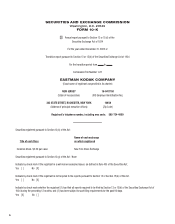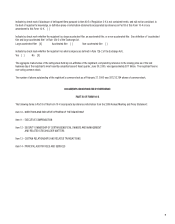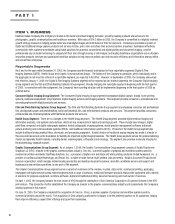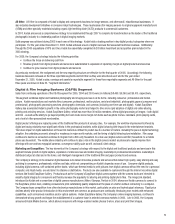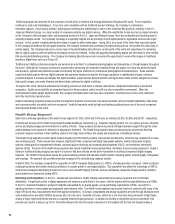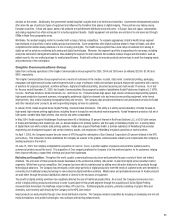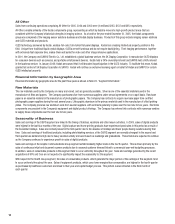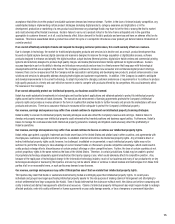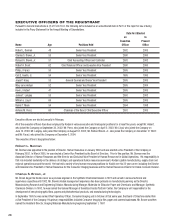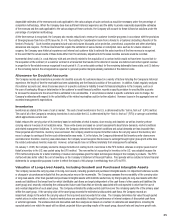Kodak 2005 Annual Report Download - page 18
Download and view the complete annual report
Please find page 18 of the 2005 Kodak annual report below. You can navigate through the pages in the report by either clicking on the pages listed below, or by using the keyword search tool below to find specific information within the annual report.16
prohibiting Kodak from marketing or selling certain of its products. Even if Kodak has an agreement to indemnify it against such costs, the
indemnifying party may be unable to uphold its contractual agreement to Kodak. If we cannot or do not license the infringed technology at all or
on reasonable terms or substitute similar technology from another source, our revenue and earnings could suffer.
If we are not successful in transitioning certain fi nancial processes and administrative functions to a global shared services model and
outsourcing some of their work to third parties, our business performance, cost savings and cash fl ow could be adversely impacted.
The Company continues to migrate various administrative and fi nancial processes, such as general accounting, accounts payable, credit and
collections, call centers and human resources processes to a global shared services model to more effectively manage its costs. Delays in the
migration to the global shared services model and to third party vendors could adversely impact the Company’s ability to meet its cost reduction goals.
Also, if third party vendors do not perform to Kodak’s standards, such as a delay in collection of customer receipts, the Company’s cash fl ow could be
negatively impacted.
Our inability to develop and implement e-commerce strategies that align with industry standards, could adversely affect our business.
In the event Kodak were unable to develop and implement e-commerce strategies that are in alignment with the trend toward industry standards and
services, the Company’s business could be adversely affected. The availability of software and standards related to e-commerce strategies is of an
emerging nature. Kodak’s ability to successfully align with the industry standards and services and ensure timely solutions requires the Company to
make accurate predictions of the future accepted standards and services.
System integration issues could adversely affect our revenues and earnings.
Kodak’s completion of planned information systems upgrades, including SAP, if delayed, could adversely affect its business. As Kodak continues to
expand the planned information services, the Company must continue to balance the investment of the planned deployment with the need to upgrade
the vendor software. Kodak’s failure to successfully upgrade to the vendor-supported version could result in risks to system availability, which could
adversely affect the business.
Our inability to effectively manage our acquisitions, divestitures and other portfolio actions could adversely impact our revenues
and earnings.
Kodak has recently completed two large business acquisitions in its Graphic Communications Group segment in order to strengthen and diversify
its portfolio of businesses, while establishing itself as a leader in the graphic communications market. At the same time, Kodak is accelerating the
current restructuring of its traditional manufacturing infrastructure. In the event that Kodak fails to effectively manage the continuing decline of its
more traditional businesses while simultaneously integrating these acquisitions, it could fail to obtain the expected synergies and favorable impact of
these acquisitions. Such a failure could cause Kodak to lose market opportunities and experience a resulting adverse impact on its revenues
and earnings.
Economic trends in our major markets could adversely affect net sales.
Economic downturns and declines in consumption in Kodak’s major markets may affect the levels of both commercial and consumer sales. Purchases
of Kodak’s consumer products are to a signifi cant extent discretionary. Accordingly, weakening economic conditions or outlook could result in a
decline in the level of consumption and could adversely affect Kodak’s results of operations.
If we do not timely implement our planned inventory reductions, this could adversely affect our cash fl ow.
Unanticipated delays in the Company’s plans to continue inventory reductions in 2006 could adversely impact Kodak’s cash fl ow outlook. Planned
inventory reductions could be compromised by slower sales due to the competitive environment for digital products, and the continuing decline in
demand for traditional products, which could also place pressures on Kodak’s sales and market share. In the event Kodak is unable to successfully
manage these issues in a timely manner, they could adversely impact the planned inventory reductions.
Delays in our plans to improve manufacturing productivity and control cost of operations could negatively impact our gross margins.
Kodak’s failure to successfully manage operational performance factors could delay or curtail planned improvements in manufacturing productivity.
Delays in Kodak’s plans to improve manufacturing productivity and control costs of operations, including its ongoing restructuring actions to
signifi cantly reduce its traditional manufacturing infrastructure, could negatively impact the gross margins of the Company. Furthermore, if Kodak
is unable to successfully negotiate raw material costs with its suppliers, or incurs adverse pricing on certain of its commodity-based raw materials,
reduction in the gross margins could occur.
We depend on third party suppliers and, therefore, our revenue and gross margins could suffer if we fail to manage supplier
issues properly.
Kodak’s operations depend on its ability to anticipate the needs for components, products and services and Kodak’s suppliers’ ability to deliver
suffi cient quantities of quality components, products and services at reasonable prices in time for Kodak to meet its schedules. Given the wide variety


